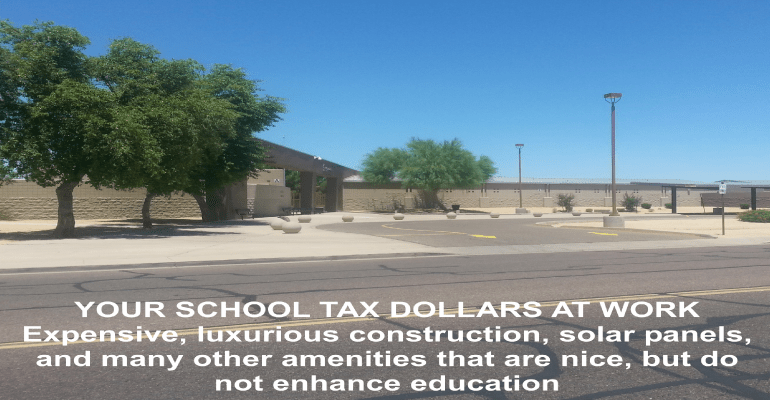
Can Arizona afford to give every K-12 teacher a $10,000 annual pay raise without increasing school budgets? As we shall see, yes we can. All it takes is for school boards to get serious about teacher compensation instead of using it as an excuse to demand more funding, of which only 53.5% has been ending up in the classroom. But first, let’s consider some background information.
An often repeated lament about teacher quality and retention in AZ is that it is nearly impossible to recruit and retain good teachers because teacher salaries are so low, especially when compared to those of neighboring states. Those doing the lamenting, further complain that schools are not being funded adequately and we need more money from the tax payers. Never mind that we already spend 43% of our state budget and 67% of our property taxes on education; that we recently raided the Trust Fund for the sake of a short term influx of cash of about $250 million; and that the Legislature this year, in concert with the Governor, increased education funding by over $260 million, most of that going to K-12, including some earmarked for teacher salary increases. Still, the calls for more funding is not abating. The latest such call came from the Superintendent of Public Instruction when she recently issued a call for a huge sales tax increase, to more adequately fund education.
With all this as a backdrop, it makes sense to do some research to find out to what extent, if any, is teacher compensation in AZ inadequate, and if so, what would be the fairest and most equitable way to address the problem.
First, let us examine how teacher compensation compares with compensation for other occupations. According to the AZ Auditor General, the average teacher annual salary is $49,189. However, any fair comparison must include all compensation, not just salary. Teachers receive an annual $13,000 in benefits, for a total annual average compensation package of $62,189. In the private sector, according to the Bureau of Labor Statistics, the average salary is $52,939, and the average value of benefits is $10,600, for a total compensation package that adds up to $63,539.
But the comparison would not be accurate if it stopped here because teachers, unlike “civilians”, do not work 12 months. The school year is only 9 months, but they do some extra work, which validates the use of 10 months for this analysis. When adjusted in this manner, the total average annual compensation package for teachers in AZ is $74,626, which compares quite favorably with the average total compensation for all other occupations.
Next, let us examine the claim that we cannot attract and retain good teachers because adjacent states have higher average teacher salaries. So, let us compare Arizona’s $49,189 basic average salary to the California counterpart, which happens to be $75,260. In terms of dollars alone, this is a huge gap. However, anyone with even the most rudimentary knowledge of economics understands that the significant data is not the number of dollars, but the purchasing power of those dollars, which has to take into account differences in the cost of living. It so happens that the California cost of living, on average is about 1.51 times that of Arizona. When adjusted for cost of living differences, the gap in salary between AZ teachers and CA teachers is fairly small, around $1,000.
The logical conclusion is that teachers in AZ are not doing quite as poorly as we are led to believe. But if we were to disregard all of the foregoing material and insist that teacher compensation must be increased, we can do it without further squeezing the taxpayers. Here is how:
DATA TAKEN FROM THE AZ AUDITOR GENERAL’S WEBSITE:
Number of K-12 students = 1,124,423
Fiscal 2016 $ per student = $9,136
Total $ for all K-12 = $10,272,728,528
2016 % of $ going to classroom = 53.5%
2004 % of $ going to classroom = 58.6%
Number of teachers = 49,000
Simple arithmetic shows us that if we were to take the 2016 level of funding and allocate to the classroom the same percentage as we did in 2004 (58.6%), we would have had an additional $524 million going to the classroom, sufficient to have given every teacher a $10,692 pay raise, without any further raping of the taxpayers. Why is this not happening? Good question for school administrators.
Editor’s Note: Archie Dickinson contributed to this article.
